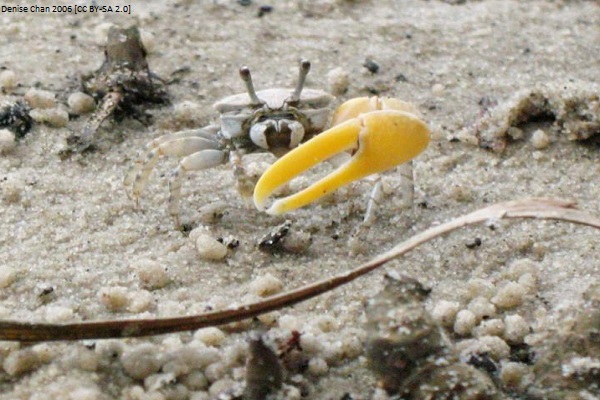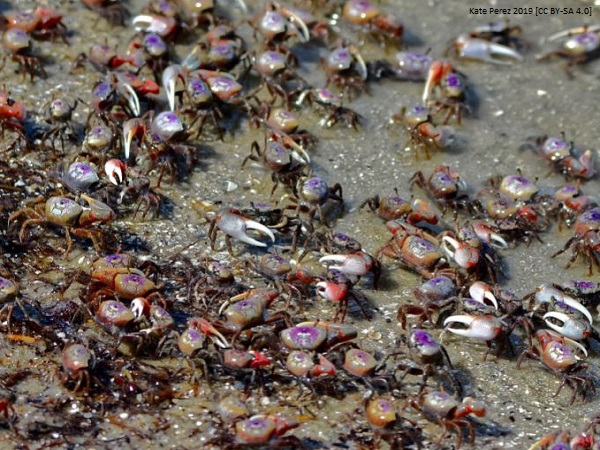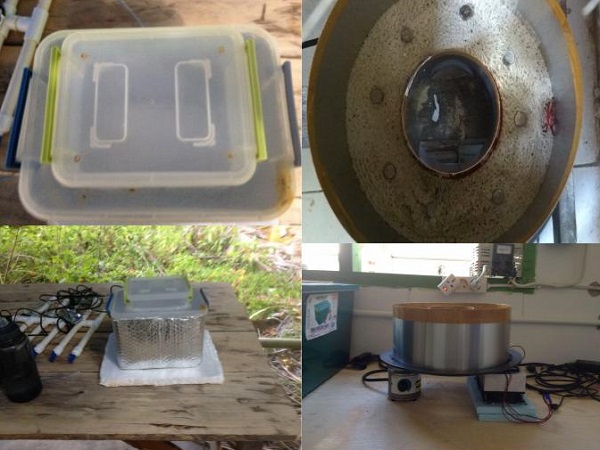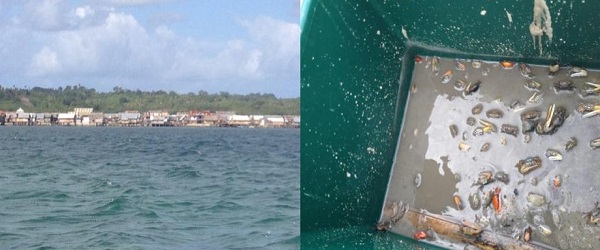by Matthew Norton
For many of us, the seashore is an idyllic landscape where we can explore and relax with a cold ice cream. But for the sea creatures who actually live at this boundary between worlds, it’s one of the harshest environments on the planet. The dangers include overheating, drying out and environmental extremes that a watery existence would normally buffer against. But, nature always finds a way and some species have risen to this challenge so well that they seem to prefer life in the air, rather than the ocean.
Fiddler crabs are a prime example since, unlike other seashore crabs, they wait until the tide has left the beach before emerging from their underground burrows to forage for food. They don’t often stray too far from a burrow, and so have the option to run back in if things get too hot out in the open. But they also need to scrounge enough from the sand to sustain themselves, so they employ a few tricks that allow them to bear the scorching heat.

They live in various seashore habitats including salt marshes and the edges of mangrove forests (with sesarmid crabs typically dominating the very depths of the mangroves). Instead of feeding directly on land based plants, fiddler crabs scavenge on the sea soaked sediment, picking up bacteria, microalgae such as diatoms and anything else they can find.
To some extent, these crabs don’t even need to try anything new, instead using methods of temperature resistance that have been tried and tested in other animals (or vice versa). These include heat shock proteins, which protect other proteins from being deformed and rendered useless by high temperatures, and dispersing heat through the evaporation of water from their shells (this is also why we humans sweat).
But to truly thrive in such an environment, one must know their limits and react accordingly (natural selection tends to show no mercy to individuals who ignore this advice). Fiddler crabs are well aware of this and employ behaviours and on the spot changes to regulate their body temperature. Some are quite clever, such as changing their orientation to the sun and the colour of their shells to absorb as little sunlight as possible. Other behaviours are little more than common sense, such as running to a burrow when it really is getting too hot and avoiding parts of the beach that are too inhospitable, even for them. That said, fiddler crabs who think long term can gradually acclimatise to hotter areas through experience and physical changes that will enhance their heat resistance, such as growth in body size.
All these adaptations will come in handy during courtship, where male fiddler crabs will push themselves to the boundaries of what they can tolerate to impress a female (some things never change). Specifically, the males wave their large claws in the air, sometimes alone and sometimes as part of a group effort. A particularly energetic display may woo a lady crab, but it will also be exhausting for the male and expose them to especially harsh conditions. Not to mention running the risk of attracting unwanted attention from predators. But such feats of endurance and daredevilry might just be what the females are looking for.

The need for male fiddler crabs to stand out with their large claws is an example of ‘sexual selection’, where a feature evolves in one gender of a species to appeal to the other. This approach tends to work because it demonstrates that the most ‘attractive’ male can still survive despite the issues that come with carrying his big claw around and waving it in the air. This suggests that they carry exceptional genes for surviving the seashore and so would be a good father for the next generation of fiddler crabs.

From a human perspective
Fiddler crabs are one of my favourite sea creatures. Not only are they fascinating and important to the functioning of many seaside habitats, but they were also the subject of my first dissertation project back when I was a student studying marine biology. Which is why I saved them for this article, which is the 40th article I have published since starting this blog in late 2017.
Their biggest influence on humanity in general is in their support of mangrove forests, which in turn can protect us from the ocean’s more destructive tendencies, such as tsunamis and coastal erosion. But since I have covered this in a previous article about mangroves, I decided to write about my experience working with fiddler crabs instead.
The story begins at Plymouth University in the autumn of 2014, at which time I was in my second year and looking for volunteering opportunities for the following summer. This led me to an event on campus that had been organised by Operation Wallacea, who run and maintain research stations all over the world. My original intention was to join an existing research project, but the chance to do the research for my third year dissertation abroad was too good to pass up.

He also came very close to stealing Charles Darwin’s thunder when he arrived at near enough the same theory of natural selection. Wallace even wrote to Darwin about his insights in 1858, seemingly unaware that Darwin had been discreetly working on this theory for around twenty years. Together, they presented this theory to the Linnaean Society, but Darwin was quick to publish his famous book “The Origin of Species” the following year.

Several months later, I embarked on a mammoth journey that consisted of two international flights, two domestic flights, a convoy of cars and a short (ish) boat ride. The eventual destination was Hoga Island (also known as Pulau Hoga), a remote island in Indonesia. Despite being homesick and knocked back by the time zone difference, it was a beautiful spit of land in the middle of Wakatobi National park.

Of course, there are drawbacks to spending six weeks in such a remote location. For starters, the lack of running water meant we had to drink bottled water and shower with buckets of cold water. The heat was also pretty intense, and with no electricity in some areas, including the sleeping huts, I can guarantee there were plenty of sticky and sweaty nights.
The health and safety orientation we attended on arrival also highlighted the less trivial aspects of life on a tropical island. These ranged from diseases and dangerous animals to coral holes and the vulnerability of our location should earthquakes and tsunamis hit the region. The words “we will make you comfortable” were used on multiple occasions, although most dangers could be averted through appropriate precautions and common sense (i.e. don’t be an idiot).

Falling into one of such coral holes was likely to result in deep cuts and broken holes due to all the hard and sticky out bits.
Once that was out of the way, and we’d all had a chance to sleep off the jet lag, it was straight to the job at hand. The first week or two was spent getting to know the other researchers on the island and setting up and testing the equipment for my experiments. On more than one occasion, my original research plan had to be modified according to the resources we had available.

To measure heat tolerance, I placed each crab in a chamber (left) and slowly increased the temperature inside until they reached a critical thermal maximum (CTmax for short). This was temperature at which the crabs were unable to right themselves after being flipped over, indicating that they were no longer able to function properly. It would have been stressful for the crabs, but the alternative was to wait to see at what temperature they dropped dead.
To measure temperature preference, I placed each crab onto a metal tray filled with a layer of damp sand (right) with a heated plate at one end and an styrofoam box full of ice at the other. The cold end was originally supposed to be a cooling fan, but in my experience you can’t have a proper scientific experiment unless something goes wrong and you’re forced to improvise. With a collection of temperature data loggers (the metal circles) and images from a time lapse camera, I was able to estimate what temperatures the crab hung around over a 12 hour period.
With that done, it was time to hop over to the nearby island of Kaledupa to collect the crabs. On this brief expedition, I was lucky enough to be accompanied by a group of Indonesian students who were incredibly skilled at catching fiddler crabs as they bolted to the safety of their burrows. I meanwhile, was absolutely hopeless and only managed to catch a couple of them through dumb luck.

These crabs didn’t really need much more than this in the wet lab back on Hoga island.
The crabs were taken back to Hoga and housed in a wet laboratory building located five minutes away (by foot) from the main site. There was a cleared path in the vegetation between the two areas, but this didn’t always prevent encounters with the island’s wildlife. Fortunately, they let me pass peacefully, as many animals will do so long as we respect their personal space.


However, on my first mud collection trip, I foolishly leapt into the mud from a low wall and was promptly up to my knees in the stuff. When I emerged, one sandal was smothered in mud while the other was lost altogether.

Unfortunately, having chosen to skip the rabies vaccination to save money (in hindsight, not my best decision) I had stick to my self-imposed rule of not touching anything with fur and claws. No matter how cute.
There were other students working on their own research projects in the wet lab, and while there was no strict ‘quid pro quo’ arrangement in place we were encouraged to help each other if we weren’t otherwise occupied. Towards the end of our time on the island, some of us went out for a bit of snorkelling. We didn’t stray far from the shore, but we still saw some beautifully coloured fish in the crystal clear water. The spectacle made up for the state I was in as water constantly leaked into my goggles and I struggled to use my flippers in a way that was even remotely effective.

The six weeks ended with a big party that involved alcohol, dancing on tables and a bonfire on the beach. The result I got from my research didn’t reveal anything particularly exciting, but it was, at the very least, a well executed piece of science, which is the most important part of any study, regardless of aims, results or where in the world the data is coming from. Still, it was an incredible experience to spend six weeks away from civilisation, albeit with some modern comforts (still can’t believe there was ice cream available on the island). I’d imagine that most people would like to get away from it all from time to time.

Sources
Eliss. 1968. Transition from water to land in decapod crustaceans
Carlson et al. 2014. Density, Shell Use and Species Composition of Juvenile Fiddler Crabs (Uca spp.) at Low and High Anthropogenic Impact Salt Marsh Sites
Emmerson and McGwynne. 1992. Feeding and assimilation of mangrove leaves by the crab Sesarma meinerti de Man in relation to leaf-litter production in Mgazana, a warm-temperate southern African mangrove swamp
Osborne and Smith. 1990. Differential predation on mangrove propagules in open and closed canopy forest habitats
Meziane et al. 2002. Role of fiddler crabs of a subtropical intertidal flat on the fate of sedimentary fatty acids
Robertson and Newell. 1982. A study of particle ingestion by three fiddler crab species foraging on sandy sediments
Feder and Hofmann. 1999. Heat-shock proteins, molecular chaperones, and the stress response: evolutionary and ecological physiology
Frenkel et al. 2008. Both heat shock and water deprivation trigger Hsp70 expression in the olfactory lobe of the crab Chasmagnathus granulatus
Somero. 2004. Adaptation of enzymes to temperature: searching for basic “strategies”
Barnwell. 1968. Comparative aspects of the chromatophoric responses to light and temperature in fiddler crabs of the genus Uca
Wilkens and Fingerman. 1965. Heat tolerance and temperature relationships of the fiddler crab, Uca pugilator, with reference to body coloration
Backwell. 2019. Synchronous waving in fiddler crabs: a review
Hews et al. 2021. Field-based body temperatures reveal behavioral thermoregulation strategies of the Atlantic marsh fiddler crab Minuca pugnax
Levinton. 2020. Thermal stress: The role of body size and the giant major claw in survival and heat transfer of a fiddler crab (Leptuca pugilator)
Darnell and Munguia. 2011. Thermoregulation as an alternate function of the sexually dimorphic fiddler crab claw
Allen and Levinton. 2014. Sexual selection and the physiological consequences of habitat choice by a fiddler crab
Takeda. 2006. Behavioural evidence for body colour signaling in the fiddler crab Uca perplexa (Brachyura: Ocypodidae)
Forward and Rittschof. 1994. Photoresponses of crab megalopae in offshore and estuarine waters: implications for transport
Frith and Brunenmeister. 1980. Ecological and population studies of fiddler crabs (Ocypodidae, genus Uca) on a mangrove shore at Phuket Island, western peninsular Thailand
Mokhtari et al. 2015. Determination of key environmental factors responsible for distribution patterns of fiddler crabs in a tropical mangrove ecosystem
McNish. Who was Alfred Russel Wallace? https://www.nhm.ac.uk/discover/who-was-alfred-russel-wallace.html?gclid=Cj0KCQjwkIGKBhCxARIsAINMioLKTOqpye8B31FA3wpfUKOG8a2Mgcx8wEnxwyR5kGpj7khDF4HRIWYaAr7dEALw_wcB. Last accessed 14/09/2021
Image sources
Kathy. 2009. [CC BY 2.0 (https://creativecommons.org/licenses/by/2.0)]. https://commons.wikimedia.org/wiki/File:Fiddler_crabs.jpg
Denise Chan from Hong Kong, China. 2006. [CC BY-SA 2.0 (https://creativecommons.org/licenses/by-sa/2.0)]. https://commons.wikimedia.org/wiki/File:Fiddler_Crab_-_Australia.jpg
Kate Perez. 2019. [CC BY-SA 4.0 (https://creativecommons.org/licenses/by-sa/4.0)]. https://commons.wikimedia.org/wiki/File:Fiddler_Crabs.jpg
Bernard DUPONT from FRANCE. 2014. [CC BY-SA 2.0 (https://creativecommons.org/licenses/by-sa/2.0)]. https://commons.wikimedia.org/wiki/File:Calling_Fiddler_Crab_(Uca_vocans)_(15717078196).jpg
Thomas Brown. 2011. [CC BY 2.0 (https://creativecommons.org/licenses/by/2.0)]. https://commons.wikimedia.org/wiki/File:Fiddler_Crab_(Uca_crassipes%3F)_(6263284060).jpg
All other images are public domain, or my own.